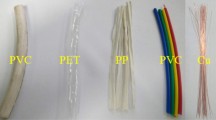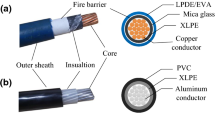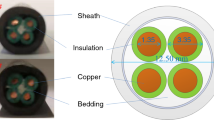Abstract
The presented study deals with the fire risk of electrical cables. Samples of three-core electrical power cables and two-core electrical control cables were investigated. The influence of the mutual spacing between the cables and the thermal conductivity of the material under the cables (underlying material) on fire risk was assessed in the study. The fire risk was determined using a cone calorimeter (at a heat flux of 50 kWm−2) and an oxygen bomb calorimeter. The fire risk was assessed based on parameters quantifying the released heat, toxicity and amount of combustion products and flashover category. The heat release rate, total heat release and the effective heat of combustion increase with increased spacing between the cables and decreased thermal conductivity of the underlying material. The carbon monoxide yield increases with the increase in the thermal conductivity of the underlying material. The influence of the spacing between cables on the carbon monoxide yield (in the interval 0–1800 s) depends on the thermal conductivity of the underlying material. At low thermal conductivity, the carbon monoxide yield decreases as the spacing decreases, with the opposite trend (with some exceptions) at high thermal conductivity. Smoke yield decreases with increasing thermal conductivity of the underlying material and also increases with increased spacing between cables. Neither the thermal conductivity of the underlying material nor the spacing between cables has an influence on the flashover category of the cables investigated.










Similar content being viewed by others
References
EN 13501-6:2014. Fire classification of construction products and building elements—part 6: classification using data from reaction to fire tests on electric cables. Brussels: European Committee for Standardization; 2014.
EN 50399:2011/A1:2016. Common test methods for cables under fire conditions. Heat release and smoke production measurement on cables during flame spread test. Test apparatus, procedures, results. Brussels: European Committee for Standardization; 2016.
IEC 60332-1-2:2004+AMD1:2015. Tests on electric and optical fibre cables under fire conditions—part 1–2: test for vertical flame propagation for a single insulatedwire or cable—procedure for 1 kW pre-mixed flame. Geneva: International Electrotechnical Commission; 2015.
Meinier R, Sonnier R, Zavaleta P, Suard S, Ferry L. Fire behavior of halogen-free flame retardant electrical cables with the cone calorimeter. J Hazard Mater. 2018;342:306–16.
Schartel B, Bartholmai M, Knoll U. Some comments on the use of cone calorimeter data. Polym Degrad Stab. 2005;88:540–7.
Carvel R, Steinhaus T, Rein G, Torero JL. Determination of the flammability properties of polymeric materials: a novel method. Polym Degrad Stab. 2011;96:314–9.
ISO 1716:2010. Reaction to fire tests for products: determination of the gross heat of combustion (calorific value). Geneva: International Organization for Standardization; 2010.
Findorák R, Frohlichová M, Legemza J, Findoráková L. Thermal degradation and kinetic study of sawdusts and walnut shells via thermal analysis. J Therm Anal Calorim. 2016;125:689–97.
ISO 5660-1:2015. Reaction to fire tests: heat release, smoke production and mass loss rate—part 1: heat release rate (cone calorimeter method) and smoke production rate (dynamic measurement). 3rd ed. Geneva: International Organization for Standardization; 2015.
Kokkala MA, Thomas PH, Karlsson B. Rate of heat release and ignitability indices for surface linings. Fire Mater. 1993;17:209–16.
Babrauskas V, Peacock RD. Heat release rate: the single most important variance in fire risk. Fire Saf J. 1992;18:255–72.
Lin X, He Y, Jiang W, Liu J, Chen M, Yao W, Ma P, Ding C, Wang J. Prediction of heat release rate of shredded paper tapes based on profile burning surface. J Therm Anal Calorim. 2017;130:2215–25.
Wolska A, Gozdzikiewicz M, Ryszkowska J. Influence of graphite and wood-based fillers on the flammability of flexible polyurethane foams. J Mater Sci. 2012;47:5693–700.
Hirschler MM. Flame retardants and heat release: review of data on individual polymers. Fire Mater. 2015;39:232–58.
Turku I, Karki T. The influence of carbon-based fillers on the flammability of polypropylene-based co-extruded wood-plastic composite. Fire Mater. 2016;40:498–506.
Moyo L, Ray SS, Sebati W, Ojijo V. The influence of filler surface modification on mechanical and material properties of layered double hydroxide-containing polypropylene composites. J Appl Polym Sci. 2017;134:1–14.
Witkowski A, Hollingberry L, Hull RT. Fire retardancy of mineral fillers in EVA copolymers. In: Morgan AB, Wilkie CA, Nelson GL, editors. ACS symposium series 1118, fire and polymers VI: new advances in flame retardant chemistry & science. Washington: American Chemical Society; 2012. p. 97–111.
Zhang J. Study of polyamide 6-based nanocomposites. New York: Polytechnic University; 2008.
Grayson SJ, Hees PV, Green AM, Breulet H, Vercellotti U. Assessing the fire performance of electric cables (FIPEC). Fire Mater. 2001;25:49–60.
Breulet H, Steenhuizen T. Fire testing of cables: comparison of SBI with FIPEC/Europacable tests. Polym Degrad Stab. 2005;88:150–8.
Gallo E, Stocklein W, Klack P, Schartel B. Assessing the reaction to fire of cables by a new bench-scale method. Fire Mater. 2017;41:768–78.
Heskestad G. Heat of combustion in spreading wood crib fires with application to ceiling jets. Fire Saf J. 2006;41:343–8.
Hirschler MM. Flame retardants and heat release: review of traditional studies on products and on groups of polymers. Fire Mater. 2015;39:207–31.
Gunther B, Gebauer K, Barkowski R, Rosenthal M, Bues CT. Calorific value of selected wood species and wood products. Eur J Wood Prod. 2012;70:755–7.
Martinka J, Hroncova E, Chrebet T, Balog K. The influence of spruce wood heat treatment on its thermal stability and burning process. Eur J Wood Prod. 2014;72:477–86.
Martinka J, Martinka F, Rantuch P, Hrusovsky I, Blinova L, Balog K. Calorific value and fire risk of selected fast-growing wood species. J Therm Anal Calorim. 2018;131:899–906.
IEC 60695-7-3:2011. Fire hazard testing—part 7–3: toxicity of fire effluent—use and interpretation of test results. Geneva: International Electrotechnical Commission; 2011.
C/VM2:2014. Verification method: framework for fire safety design. 4th ed. Wellington: Ministry of Business, Innovation and Employment; 2014.
Purser DA. Combustion toxicity. In: Hurley MJ, editor. SFPE handbook of fire protection engineering. 5th ed. New York: Springer; 2016. p. 2226–307.
Tewarson A. Generation of heat and chemical compounds in fires. In: DiNenno PJ, editor. SFPE handbook of fire protection engineering. 3rd ed. Quincy: National Fire Protection Association; 2002. p. 618–97.
Ozgen S, Caserini S, Galante S, Giugliano M, Angelino E, Marongiu A, Hugony F, Migliavacca G, Morreale C. Emission factors from small scale appliances burning wood and pellets. Atmos Environ. 2014;94:144–53.
Ostman BAL. Smoke and soot. In: Babrauskas V, Grayson SJ, editors. Heat release in fires. 2nd ed. Hampshire: Interscience Communications; 2009. p. 233–50.
Acknowledgements
This work was supported by the Slovak Research and Development Agency under the contract No. APVV-16-0223.
Author information
Authors and Affiliations
Corresponding author
Rights and permissions
About this article
Cite this article
Martinka, J., Rantuch, P., Sulová, J. et al. Assessing the fire risk of electrical cables using a cone calorimeter. J Therm Anal Calorim 135, 3069–3083 (2019). https://doi.org/10.1007/s10973-018-7556-5
Received:
Accepted:
Published:
Issue Date:
DOI: https://doi.org/10.1007/s10973-018-7556-5




